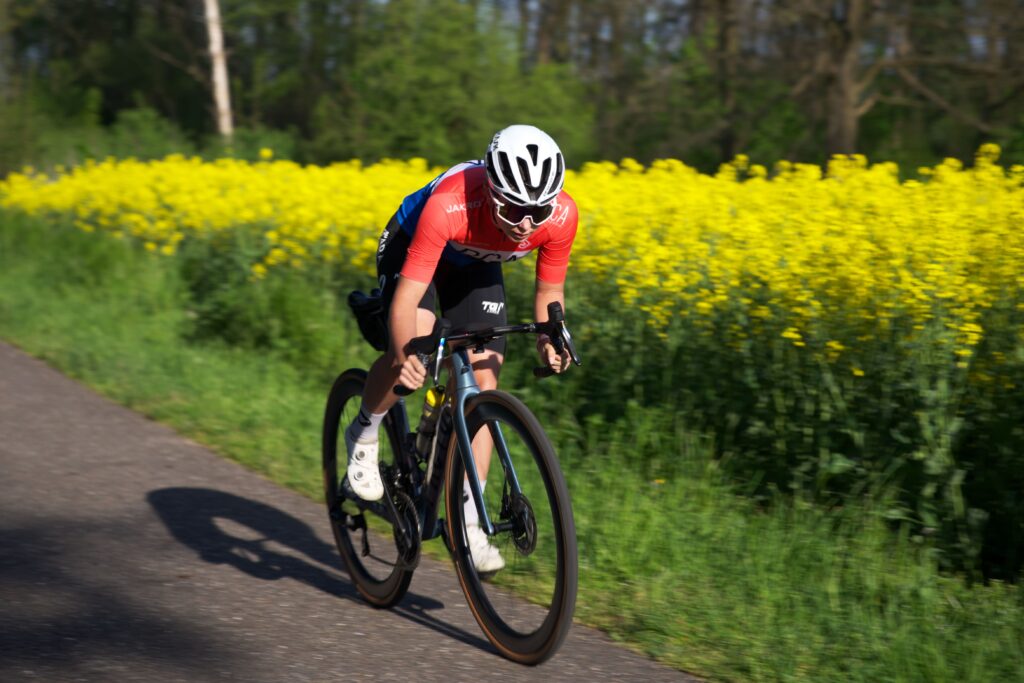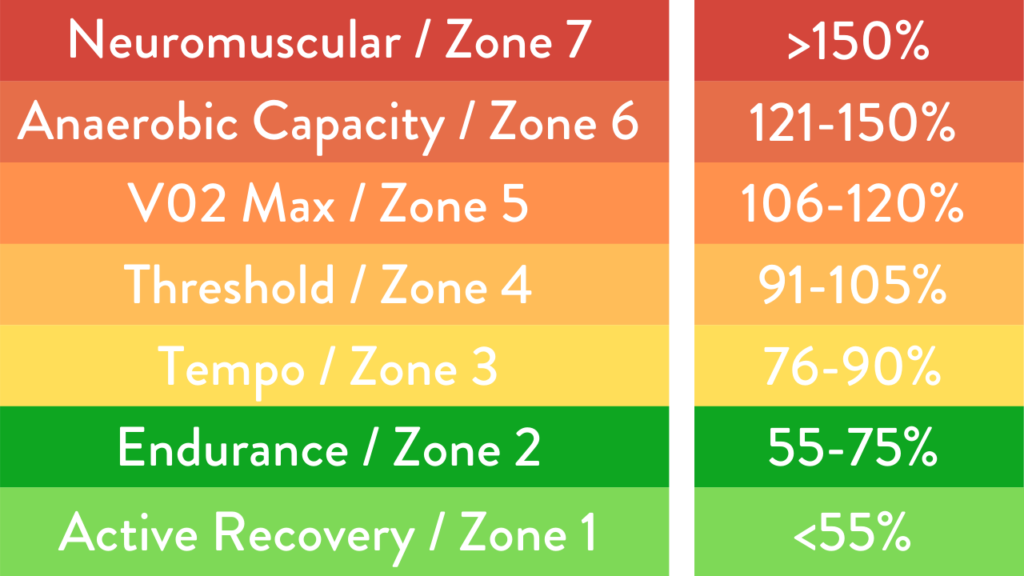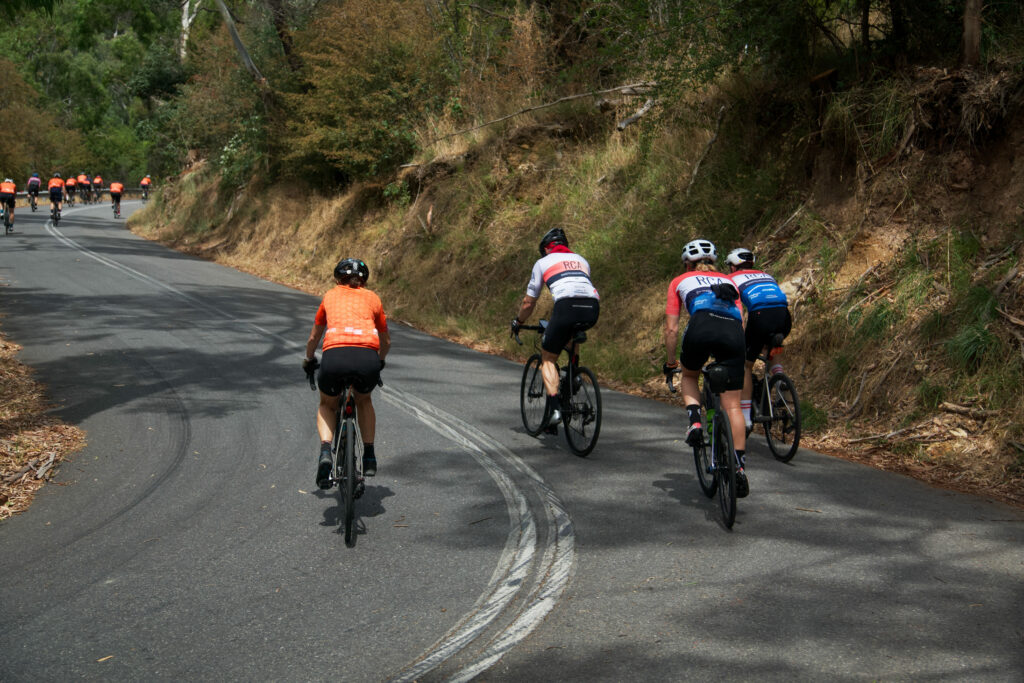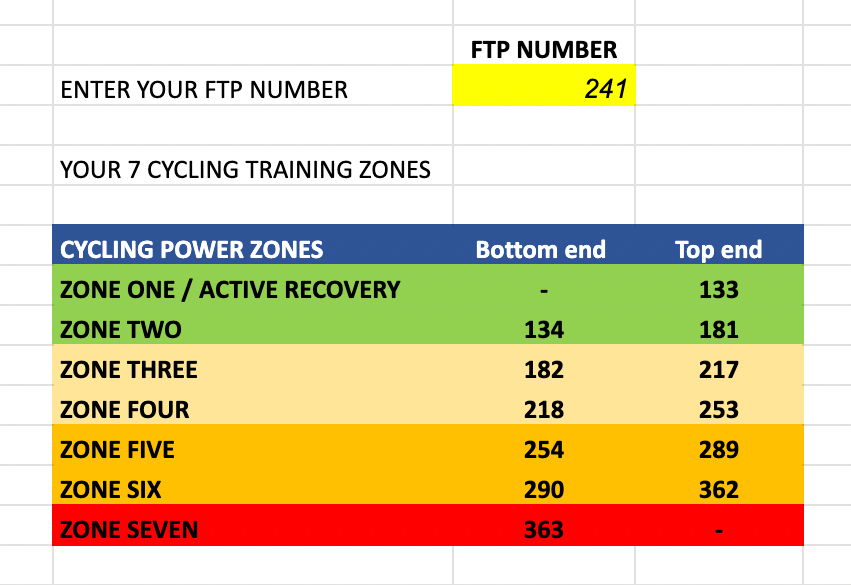Calculate your power zones and train to the right intensity.

Don’t know how to calculate your cycling power training zones?
Training by power (using a power metre, and to the correct zone), allows you to get the most out of your training. You can train at a mix of intensities based on functional threshold power (FTP) percentages to facilitate the right physiological adaptations. For example, training at zone 2 is efficient for developing your aerobic system, while zone 4 teaches your body how to clear lactate more efficiently (as well as other benefits).
Using a power metre allows you to be more intentional and accurate with your training. This blog post will explain more on cycling power zones, and then we’ll finish by providing you with a power calculator to find your ideal zones based on your FTP.
Why train using power?
At the RCA, we’re a big proponent of training by power.
Training by power on the bike is like lifting weights in the gym — you wouldn’t blindly pick up weights and hope they weren’t too light or too heavy. So why do the same with your cycling power zones? Instead, you can train in the right zones to promote the necessary physiological adaptations, e.g. improving your VO2 Max, increasing your lactate threshold, and improving muscle glycogen utilisation.
Unlike heart rate (HR), power is more tangible — it allows you to target training zones much more effectively. And while you can still train using HR, we would recommend so in combination with power.
How to calculate your power zones
To get accurate power zones, you need to complete an FTP test. There are many options available, but at the RCA, our members do the Wahoo Half Monty on an indoor trainer. And if that’s not possible, a 20-minute test outside is typically your next best option.
Doing an FTP test ensures your zones are accurate. Therefore, you’ll need to perform FTP tests every few weeks (a great activity to do on recovery weeks) to ensure you train in the right zone and get the most out of your training sessions.
You can see the power zones below:

Power training zones
We’ll break down each of the 7 zones below, including what they’re used for and why you should train at each intensity.
Active recovery: Zone 1
Zone 1 is the least intense of all the zones, i.e. it produces very few physiological adaptations. But it still has its place in your training plan — it’s used for active recovery spins after an intense day on the bike, and is also used as a recovery between high-intensity efforts. You should be able to hold a continuous conversation in this zone.
When training at zone 1, the aerobic system uses (almost exclusively) slow twitch type 1 muscle fibres. This is known as the active recovery zone because your body delivers oxygenated blood to tired muscles, transports essential nutrients and removes waste products to improve recovery.
Endurance: Zone 2
Zone 2 generates more fatigue than zone 1, but it’s still relatively low intensity and promotes a mix of adaptations. One study [3] mentions key physiological adaptations that take place from training in zone 2:
- Increased mitochondria (more energy to ride further)
- Musculoskeletal adaptations (increased slow twitch type 1 fibres)
- Expanded capillary density (improved muscle function)
Endurance training is your classic long slow distance zone — it should have its place in every rider’s schedule, and yes, that includes during the build and peak phases. It’s the best intensity for long and moderate-duration riding.
Related: Zone 2 Training for Cycling: How to Improve Your Aerobic Endurance.
Tempo: Zone 3

Many cyclists find themselves in zone 3 by accident, when they should be in zone 2. This is especially true for cyclists who train by feel or HR, and not by power. But training at zone 3 triggers the lactate system and causes chemical changes at the muscular level. This causes more fatigue and creates fewer aerobic adaptations, i.e. you build up more fatigue with fewer benefits.
But that’s not to say that zone 3 is not at all useful! For example, zone 3 can be a fantastic tool for beginners new to interval training, and for those who want to develop their upper-end aerobic capacity (so long as they are experienced and have mastered zone 2).
Each interval should be 10-60 minutes in the tempo zone (2:1 work to rest ratio).
Threshold: Zone 4
Zone 4, also known as threshold, is when the body produces lactate faster than it can be removed — this also reduces muscle force production and limits performance. The threshold zone is the maximum power you can sustain for around the 1 hour mark [2].
Training at threshold increases your body’s efficiency at clearing and withstanding higher lactate levels. Over time, you’ll be able to cycle at a higher FTP (for longer) with less fatigue. Threshold training can improve endurance, lactate clearance, and maximum sustainable power. And because you’re also using the anaerobic energy system more, you also develop the anaerobic systems [3].
Each interval should be 5-20 minutes in the threshold zone (2:1 work to rest ratio).
VO2 Max: Zone 5
VO2 Max is often described as the maximum oxygen uptake that can be utilised by the body during severe exercise [1]. Training at zone 5, or your VO2 Max, usually takes place in the form of intervals (1-5 minutes).
These interval efforts are highly demanding and work both the aerobic and anaerobic systems to produce energy. Zone 5 training contains many benefits but the most notable are as follows:
- Increased blood plasma volume (less cardiac output to sustain the same effort)
- Improved lactate threshold (body becomes more efficient at clearing lactate)
- Increased stroke volume (more blood can be pumped to the working muscles with less effort)
And while training at your VO2 Max improves maximum oxygen utilisation, it’s very demanding. So you need to build the foundations first with zone 2 endurance training.
Each interval should be 2-8 minutes in the VO2 Max zone (1:1 work to rest ratio).
Anaerobic capacity: Zone 6

The highest level of intensity — that is not a sprint — is the zone 6 anaerobic zone. It’s called the anaerobic capacity because power is produced exclusively via anaerobic metabolism. Type 2b fibres are also doing most of the work.
Zone 6 efforts last no more than a few minutes — these are short and quick explosive bursts that require a lot of power. Riding at your anaerobic capacity increases your body’s ability to deal with lactate and also increases anaerobic utilisation.
Each interval should be 30s to 2 minutes in the anaerobic zone (1:2 work to rest ratio).
Neuromuscular: Zone 7
The final zone, the neuromuscular zone 7, is your maximum power output — it typically lasts no more than 60 seconds. It’s the power zone you tap into in the final sprint of a race, or when riding over a very steep climb out of the saddle.
Each interval should be 5-30s in the neuromuscular zone (1:5 work to rest ratio).
What should my power training zones be?
To calculate your cycling power zones, you first need to do an FTP test, as previously mentioned. Once you’ve got an up-to-date FTP score, enter this into a cycling power zone calculator to find what power (%) you should train at to hit the right zone.
You can use the RCA power zones calculator to find your bottom-end and top-end power for each of the 7 zones. We also provide you with HR data, but remember: this is best used to complement your training; power is a better (and more tangible) indicator of effort.

Cycling training zones: to conclude
Training by power, and using the right power zone, allows you to shift your intensity as needed to facilitate the necessary training adaptations. This allows for more efficient cycling and training. You can eliminate excess fatigue and the buildup of lactate on easy zone 2 rides, and make sure you train hard when doing high-intensity efforts.
Key takeaways:
- Train by power to achieve the necessary physiological adaptations
- Do a functional threshold power test and use an FTP calculator to find your power zones
- Ride at a mix of zones (dependent on your training phase) to get the most out of your training
FAQs
What is my zone 2 power cycling?
Zone 2 training is approximately 55% to 70% of your FTP. So if your FTP is 250, your zone 2 will be between 137w and 175w.
Is zone 2 better than zone 3?
Zone 2 training is less intense than zone 3 and contains less lactate build up, making it the more efficient zone for aerobic training and development.
Which zone is best for fat burning?
If your goal is to burn fat, zone 2 is where you should spend your time.

